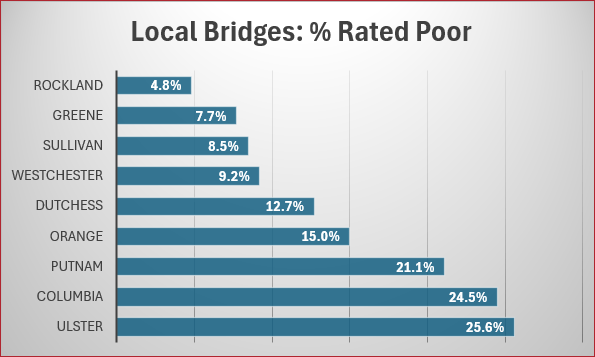|
RCBJ-Audible (Listen For Free)
|
Hudson Valley Property Owners Association And Landlords File Suit Challenging Poughkeepsie’s Adoption Of ETPA
A group of Poughkeepsie property owners, along with the Hudson Valley Property Owners Association (HVPOA), filed suit last week in Dutchess County Supreme Court seeking both temporary and permanent relief asking a court to invalidate Poughkeepsie’s declaration of a rent emergency and adoption of the Emergency Tenant Protection Act (ETPA).
The ETPA allows any municipality to declare a rental “housing emergency” if it determines that a class of buildings with six or more units constructed before January 1, 1974 have a vacancy rate under 5 percent. With that finding, the municipality, with the NY Division of Housing and Community Renewal can impose rent stabilization on the buildings in that class. Rent stabilization mandates limited rent increases and automatic renewals of leases, restricting the landlord’s ability to raise rents or decline renewals of existing tenants.
The landlords and the HVPOA, a nonprofit association representing the interests of property owners in the Hudson Valley claim Poughkeepsie’s study that yielded a vacancy rate of 4.03% was fatally flawed as it omitted several vacant units from the study and improperly determined buildings it deemed non-responsive as having zero vacancies. According to a detailed review of the methodology used by the organization that conducted the study, the actual vacancy rate exceeded 5%, rendering Poughkeepsie ineligible for participation in the ETPA,
According to its website, the HVPOA opposes the ETPA asserting that it creates a disincentive for investment in housing, precludes updating of older buildings most in need of maintenance and repair, deprives landlords of a return on their investments, and unfairly requires a small class of landlords to solve the larger societal problem of an inadequate number of housing units.
The plaintiffs/petitioners have asked for temporary relief maintaining the status quo and permanent relief invaliding the adoption of the study and the declaration of a housing emergency in Poughkeepsie.
The Court as per Justice Christi J. Acker, granted HVPOA’s motion for a Temporary Restraining Order halting implementation of the ETPA. The order grants the following relief:
- Directs that landlords in the City of Poughkeepsie shall not be required to register their properties for Emergency Tenant Protection Act (ETPA) regulation with the NYS Division of Housing and Community Renewal until further order of this Court;
- Provides that owners of housing accommodations subject to the Emergency Tenant Protection Act (ETPA) in the City of Poughkeepsie shall not be required to provide tenants with new or renewal leases; and
- Provides that all affected tenants in housing accommodations subject to the Emergency Tenant Protection Act (ETPA) shall have the right to continued occupancy as month-to-month tenants, notwithstanding the expiration of their prior lease or lack of a new lease; and
- The legal rent that may be charged to affected tenants in housing accommodations subject to the Emergency Tenant Protection Act (ETPA) shall be the rent charged and paid in the first rent payment on or after June 18, 2024.
Comptroller’s Office Issues Report On Condition Of Hudson Valley’s Locally-Owned Bridges
An infrastructure report issued by Thomas DiNapoli’s Office describes the condition of locally-owned bridges, county by county, with some sobering news. Statewide, 10 percent of all local bridges were rated in “poor” condition in 2023. Local bridges include those owned by counties, towns, and villages. State and federally-owned bridges were not included in the report.
The data was provided by the Federal Highway Administration’s (FHWA) National Bridge Inventory (NBI) which maintains detailed data on all highway bridges across the nation. Highway bridges include bridges, culverts or interchanges longer than 20 feet located on public roads.
New York State requires that all bridges be inspected every two years at a minimum. Local governments owned 50.6 percent of New York’s 17,573 bridges.
Scores in the Hudson Valley varied dramatically.
In Ulster County, 25.6% of its 246 bridges rated poor. In Columbia, 24.5% of its 139 rated poor. In Putnam, 21.1% of its 38 bridges rated poor. In Orange, 15% of its 206 bridges rate poor. In Dutchess, 12.7% of its 181 bridges rated poor. In Westchester, 9.2% of it 228 bridges rated poor. In Sullivan, 8.5% of its 247 bridges rated poor. In Greene, 7.7% of its 142 bridges rated poor. And, in Rockland, 4.8% of its 83 bridges rated poor.

When NYSDOT inspects a bridge, it assigns a rating or score – ranging from 0 (worst) to 9 (best) – to major bridge components based on their capacity to carry vehicular loads. Upon completion, the inspection data is forwarded to FHWA, which assigns an overall rating of
“good”, “fair” or “poor” to each bridge, based on the component ratings. If any major component (deck, superstructure or substructure) receives a score of 4 or below, the bridge is rated “poor.” Bridges with the lowest component rating falling in either a 5 or 6 are determined to be in fair condition, while a good condition rating indicates that all component ratings are at or above a 7.
According to the report, a bridge rated in poor condition is not considered unsafe or in imminent risk of collapse, but it may be posted with certain capacity restrictions.
Nearly half (46.8 percent) of all local bridges in the State were built before 1974, making them more than 50 years old. Estimated improvement cost for local bridges in the mid-Hudson region topped $2.1 billion, according to the Comptroller’s report.
DEC and Trust for Public Land Acquire 505 Acres in Dutchess County
Land Acquisition Safeguards Wildlife Habitat, Guarantees Public Access, and Provides Larger Buffer to Appalachian Trail Corridor
The New York State Department of Environmental Conservation (DEC) and Trust for Public Land (TPL) announced the permanent protection of 505 acres in Dutchess County. The State’s land acquisition will create the new Grape Hollow State Forest, providing enhanced wildlife habitat protection and a larger buffer for the adjoining Appalachian Trail corridor.
 “Grape Hollow State Forest will provide enhanced public access to 505 acres of intact forest in fast-growing Dutchess County, preserving critical habitat and wildlife migration corridors. In addition, this acquisition bolsters Governor Hochul’s efforts to conserve 30 percent of New York’s lands and waters by 2030,” DEC Interim Commissioner Sean Mahar said. “DEC thanks the Trust for Public Land for their partnership in helping fulfill DEC’s commitment to protecting the Hudson Valley’s natural resources.”
“Grape Hollow State Forest will provide enhanced public access to 505 acres of intact forest in fast-growing Dutchess County, preserving critical habitat and wildlife migration corridors. In addition, this acquisition bolsters Governor Hochul’s efforts to conserve 30 percent of New York’s lands and waters by 2030,” DEC Interim Commissioner Sean Mahar said. “DEC thanks the Trust for Public Land for their partnership in helping fulfill DEC’s commitment to protecting the Hudson Valley’s natural resources.”
TPL acquired two properties in the towns of Beekman and Pawling in 2023: a 405-acre property previously at risk for development and known as Depot Hill; and a 100-acre parcel in the Girl Scouts’ Heart of the Hudson Chapter’s Camp Ludington property. TPL conveyed the land to DEC to manage as State Forest, which guarantees public access and the permanent protection of wildlife habitat.
The new Grape Hollow State Forest provides an expanded natural buffer and viewshed protection for the adjoining Appalachian Trail Corridor as it runs through the town of Beekman. The Appalachian Trail, stretching 2,194 miles across 14 states from Georgia to Maine, is one of America’s most iconic long-distance hiking trails.
DEC purchased the parcel using $1.3 million from the State’s Environmental Protection Fund (EPF) and $1.3 million provided by the U.S. Fish and Wildlife Service through the Highlands Conservation Act. TPL received funding from the Appalachian Trail Conservancy’s Wild East Action Fund and private donors, including the Peter and Carmen Lucia Buck Foundation, Leonardo Locascio, and the law firm Cleary Gottleib Steen and Hamilton LLP.













